main: July 2005 Archives
Still Life with Blue Tablecloth, 1909
Matisse at Work
As Matisse became less fauve and more the artist we love, he began to depict fabrics that joyously overwhelm all other subject matter. He painted images of : tablecloths, exotic costumes worn by otherwise depersonalized women, wall hangings. And, by shifting slightly to see that it was not the cloth itself that interested him but the patterns, then wallpaper too is a subject.
Because we suddenly have access to the fabrics that the artist collected over the years, the fabrics rather than the patterns are emphasized in "Matisse: The Fabric of Dreams -- His Art and His Textiles" (Metropolitan Museum of Art, 1000 Fifth Avenue at 82nd Street, to September 25, 2005).Cloth is physical; patterns are conceptual. The fabrics are the embodiment of patterns, most often floral in Matisse's fabric library. What this has to do with dreams is beyond me. Do patterns equal the Exotic Feminine and the non-European -- and therefore equal dreamy Orientalism and sexism?
More important, why did Matisse turn to patterning? I think there was more involved than merely that he came from a family of weavers. I ask this question because it is obvious that the history or origin of his fabrics meant little or nothing to him; high art or low art, they were all the same. This jumble of sources helped him create the flatness of his paintings. Not an artist with a high degree of toleration for emptiness, they allowed him to fill in the blanks.
We know that patterned fabrics are two-dimensional, the patterns themselves usually not very illusionistic. What is the depth of a printed rose, an hibiscus, a ribbon, a bouquet or even a minilandscape? The space of patterning is the meeting place of your thumb and your forefinger when, tip-to-tip, they are brought together; it is all surface. In real life, the patterning space is tactile; in paintings it is optical. Matisse used images of patterned fabrics as excuses for color and, oddly enough, when juxtaposing patterns, to create space.
* * *
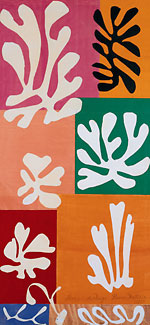
Snow Flowers, 1951
A Serious Exhibition
The first room in the exhibition is the best in terms of the exhibition theme. We see the cheaply printed, indigo dye-resist tablecloth up on the wall, a little worse for wear, near the magnificent Still Life with Blue Tablecloth, and then the much smaller The Guitarist and Pansies, where our sad piece of fabric -- miraculously transformed -- makes other appearances. Although the degrees of precision and the tonalities change from painting to painting, as required by the orchestration of the forms, the cloth is inadvertently glamorized and eternalized. Fabrics are to Matisse as apples were to Cézanne. The difference is that Matisse opens and widens the focus of our gaze, whereas Cézanne his elder, and the elder of us all, kept his surrogate saints and holy figures stage-center. In Matisse there are no saints.
Then in the next room there is a wall of fabrics, which, if it were dated 1977, might be mistaken for a Patterning and Decoration assemblage. One assumes the curatorial staff wanted to show a goodly proportion of the fabrics Matisse had collected without the Cartesian need to match each one with a paintings.
This accomplished, we move into the dreaded Nice period. Matisse was not particularly good at situating a figure in space; the Nice paintings of 1920 (e.g., Figure on Ornamental Background, etc.) show this. Only, in the '30s, when he flattened his women to match the patterned bolts of cloth (Red Robe and Violet Tulips, etc.) did he conquer space and create a new space, owing a bit to Cubism, but nothing to the Renaissance.
It is here that my mind wanders. How can I admire both Matisse and Duchamp? One artist celebrates patterned fabrics and the other urinals and bicycle wheels. One is image, the other idea; one is beauty and the other thought. And I have both my desert island and my pork-or-beef argument. But before I come to my answer -- you'll find it at the very end of this essay -- I stop in front of a 19th century Egyptian appliqué wall hanging. It dawns on me that this is as beautiful, as thoughtful, and as important as anything I have seen so far.
However, turning a corner, we come upon the Matisse cut-outs: mature, beautiful, perfect. In his golden years Matisse figured out how to make empty space solid.
Sadly, although the Matisse show is exactly the kind of exhibition museums should be doing, we hit a major problem. The label says that both Oceana, The Sky and Oceana, The Sea (1946) were inspired by the artist's memories of a trip he took to the South Pacific in 1930. What? So where is the fabric? The weak offerings of geometric African kuta clothes, as far as I can see, have no connection to the Oceana works and the othelate cut-outs.
But I know something the curator doesn't know. I know the source. Matisse may not have had examples in his personal collection, but the source fabrics are so vivid that it is not hard to imagine that he carried them around in his head.
The following is an illustration of how life and art intersect, rather than how art historians get caught in their own logic -- although probably perfectly well-meaning -- and their lack of information.
* * *
My Tahiti
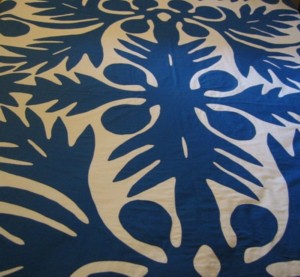
(detail) Tahitian BreadfruitTifaifai , c. 1880? - 2001
I was recruited to keynote a conference at the University of Australia, Canberra, as part of a residency hosted by both the glass and theory departments. On the flight down, the plane stopped to refuel at Fiji. We all had to get off the plane and circle through the tiny airport, a convenient gift shop in our path, where I bought my first pareus (sarong?) neatly encased in plastic. But since the "inside" of the airport was outdoors, there was a delicious scent of tropical flowers in the humid night air: my introduction to the South Pacific.
A few years latter I was invited to an Ausglass Conference in Wagga Wagga (Ausglass is an association of Australian glass artists). Wagga is inland, sheep-ranch country, and, in the local Aboriginal language means Place of Many Crows. The National Art Glass Collection is housed in the Wagga Gallery of Art. Don't ask why.
Does anyone remember the critic Gregory Battcock? His anthologies such as The New Art and Minimal Art may no longer be used in art colleges, but in the '70s they were essential. In any case, Gregory was a great inspiration to me. Through him I learned the important principle of "art-travel triangulation." I remember once he was a guest of some very famous Franco-Texans, and although we were flown down to Houston in a corporate jet, Gregory managed to wangle a return passage by way of Puerto Rico at no extra cost to our hosts. He, a licensed travel agent himself, had found an airline that was going from Houston to New York via San Juan.
So I asked my travel agent if on my second trip to Australia I could get off the plane at Fiji and stay a few days. He answered with a question: why don't you stop off at Tahiti instead? The stopover cost was $100, and it was all on my own dime, so I wouldn't have to tell some committee that my father had once docked there as a Merchant Marine and I was looking for my half-brother so I could give him his share of inheritance; nor did I have confess that I am the last descendent of Gaugin, Melville, or Robert Louis Stevenson.
So there I was in a waterfront hotel (c. 1965) on the Blvd de Pomare in Papeete, the capital of Tahiti. A few days later -- before I departed by catamaran (car-carrying and equipped with TV monitors showing taped installments of The Beverly Hillbillies) to the sister island of Moorea, which would prove to have even more drag queens than Tahiti itself, but no McDonald's in sight -- I noticed a small sign on one of the older buildings, two or three numbers down from my rusty hotel.
The handwritten sign was for an art gallery located in the very room that Matisse had stayed in when he visited Tahiti in 1930. I went upstairs. The art on sale was touristy, but right there at the end of the room was the ornamental balcony I remembered from a painting in my teenager's Matisse chapbook. Posted on a wall was postcard proof. Even the view beyond the ironwork was the same: from that window I could see where the ocean liners and steamships docked, and the large tent that housed a kind of shopping mall of Tahitian craft.
How long had they sold crafts there? I wondered. Probably as long as there were tourists coming to Tahiti by boat.
So after skirting the waiting room for passengers headed to the Marquesas, Gauguin's finally resting place only 800 miles away, I was introduced to the Tahitian appliqué coverlet.
Several stands inside the big tent I had seen from the Matisse window featured this "women's work," as it is called, or tifaifai, which is pronounced tee-fah-ee-fa-ee. The appliqué hangings and/or coverlets are rather like some traditional Hawaiian quilts I know, which go back to at least 1870. But because the tifaifai are not actually quilted, the highly stylized, flat images of fruits and flowers, similarly cut out of a single piece of cloth, are particularly vivid. In spite of their Rorschach symmetry, they are so very Matisse that you cannot believe your eyes.
Tahitian appliqué has been produced continuously since the late 19th century. In fact, I saw a small publication that included black-and-white photographs of local dignitaries hosting a ceremonial visit from some Westerners in front of an array of appliqué cloths. One was exactly like the one I bought: the breadfruit pattern.
Since the Hawaiian quilt resulted from the marriage of tapa cloth traditions and the Western quilts brought to the Sandwich Islands by missionaries, it is likely that something similar happened in Tahiti. Or perhaps the Tahitian's were directly influenced by the Hawaiian quilts? Or vice versa?
I cannot believe that Matisse did not see Tahitian appliqué in the crafts market so near his hotel, or perhaps on the bed in his room. And then once seen, how could he forget them? He didn't.
Some anthropologists and students of material culture (see George Kubler's influential The Shape of Time) believe that the way you tell art from the other stuff is that art exhibits extremely rapid nonutilitarian changes of form. We might want to investigate this notion at some further time, but if you are willing to exclude hammers and nails from the art category, then this criterion will do as well as any other.
It would seem that Tahitian appliqué has not changed for at least a hundred years and therefore is probably not art. If my theory that he appropriated his super-flat imagery from tifaifai is correct, Matisse did for Tahitian cut-outs what Duchamp did for plumbing.
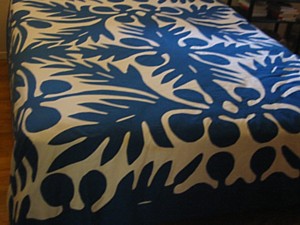
Next time: On to the Marquesas.
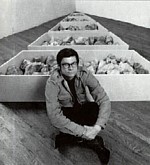
Robert Smithson (1938-1973), c. 1968
Once you have approached the mountains of cases in order to mine the books from them
and bring them to the light of day---or rather of night---what memories crowd in uponyou!-- "Unpacking My Library" in Illuminations, Walter Benjamin
By The Book
To my mind, the most interesting aspect of the catalog for the Robert Smithson retrospective (now at the Whitney) is the book-by-book, magazine-by-magazine, record-by-record record of the artist's library, compiled by Valentin Tatransky.
This is not because my 1969 book of poems Luck (Kulchur Press) is listed -- did I give it to him, or did he buy a copy when I had that autograph party at the Gotham Book Shop?
No, I like the catalogue of Smithson's library because it reminds me how well-read and intellectually curious he was. Unlike some of the Ivy League minimalists, Smithson was a true intellectual. But perhaps this was because he was self-educated. Too many now evince amazement that Smithson escaped so-called higher education: he was so smart, so informed and such a good writer.
Alexander Alberro's little essay, "The Catalogue of Robert Smithson's Library" points out some oddities among the 1,000 or so items that Smithson left behind: No copies of Artforum! Maybe Smithson had copies in his filing cabinet of his own essays that had been published there, and perhaps he had no interest in re-reading Annette Michelson or Michael Fried. Yet there is also no copy of J. G. Ballard's The Crystal World. To whom had he loaned it? The mystery of the inclusion of L. Ron Hubbard's Dianetics, along with Georges Bataille and Claude Levi-Strauss, is really no mystery at all if you remember Smithson's love of science fiction and Hubbard's "humble" beginnings as a pulp sci-fi success.
Here are some books in Smithson's library that were surprising: William Rubin's Modern Sacred Art and the Church of Assy; Owen Barfield's Poetic Diction: A Study in Meaning; Raynor Heppenstall's Leon Bloy; Mao Tse-Tung on Literature and Art; Literary Criticism of Alexander Pope. I was surprised not to find anything by his friend Hubert Selby (Last Exit in Brooklyn) and at the absence of William Carlos Williams' Paterson (although Kora in Hell was there). Williams was Smithson's baby doctor, and Paterson is the industrial neighbor of Clifton where the artist grew up.
But we are certainly are not surprised by the Bhagavad-Gita, The Book of the Dead, Edmund Husserl's Ideas, Hannah Arendt's On Violence, or Illuminations, Hannah Arendt's anthology of writings by Walter Benjamin. Nor that in his record collection, Country Joe and the Fish and Marlene Dietrich are somehow in the same audio universe as motets by Francois Couperin.
Predictably and sadly, Alberro cannot resist stating about Smithson's library "That an artist with no formal academic training compiled it is astonishing." More astonishing to me is that artists with "formal academic training" nowadays have no libraries at all.
When I make studio visits, I no longer wonder where all the books are. I know there are none. This started around 1974. Since I am really Candide in disguise, I used to think book-free studios were just an attempt at elegance. What purity. The artist did not want me to be distracted by piles of reading material. They themselves did not want to be pulled from their easels by James Joyce or Martin Heidegger. Or Hart Crane. All the books, I used to think, must be hidden away in the bedroom. Since I read voraciously, I thought all artists did.
Now I just accept it; artist's don't read. I am not sure if it's because they don't like to read, or they just can't read. I hate to think that visual creativity is just compensation for illiteracy. Perhaps art schools and college and university art departments have also fallen to what Jane Jacobs, that lovable scold, calls "certification" as opposed to "education" in her new book, cheerfully titled Dark Age Ahead.
But I can imagine something else. The artists are getting all their information through the internet.
Well, not yet. Many more books have to be scanned.
* * *
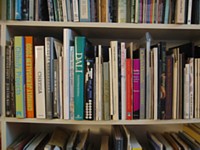
John Perreault. (detail) Bookwork, 2003
All Booked Up
These musings lead me to think about my own library, presently numbering around 4000. In the 1940s, when the notorious Collyer brothers were disinterred from the 180 tons of junk they had amassed, the NYPD not only discovered 14 grand pianos, two organs, a clavier, six tons of old newspapers, and the chassis of a Model T Ford, they found a library of 14,000 engineering and medical books. As far as I can determine, neither brother was an engineer or a doctor.
Occasionally the ghost of my sainted mother visits. She wags her finger and accuses me again, as when I was a teenager, of being a Collyer brother. She never understood how important to me were my father's African souvenirs, or my small collection of turtle shells. She could not distinguish between collecting and hoarding. The Collyer brothers hoarded. They never played their 14 grand pianos. I use my 4000 books -- at least potentially -- and they are more or less well-ordered.
They do add up.
Just yesterday I estimated I had at least 1200 books in my tiny East Village apartment. My Long Island hideout has a 14-foot-high wall of jam-packed book shelves; I need a ladder to get to the top four shelves, which function as deep storage. There's also the four shelves of books (and piles too) in the closed-in carport.
I am not boasting. I know a pair of dance critics whose commingled libraries take up all the wall space in their rather large West Village apartment: floor to ceiling, corner to corner in all the rooms, including the two bathrooms and the kitchen.
My books also just keep on accumulated. Like most bibliophiles, periodically I try to weed them out, but after days of making try-to-sell and just-throw-out piles, both piles miraculously start shrinking, and all but two or three books go back to their designated shelves, for from out of nowhere I am reminded of the Law of Books: Any volume that I get rid of absolutely will be needed within two weeks time, will have gone out of print, and will alone house that one juicy quote I think I need to clinch one argument or another or make my text more vivid.
Finally, the two or three orphans go back home too, because you never know when they will be irreplaceable and sorely missed. The Folk Toys of Uzbekistan? Will be worth hundreds of dollars on e-Bay. The Blood Sport Marble Tournaments of Maine? Gotta stay.
The Book Devil has spoken.
* * *

Hart Crane (1899-1932)
Amusing Problems of Bi-location and Retrieval
Before Long Island, I kept most of my books in a self-storage warehouse near the West Side Highway. Not having a formal cataloging system, I relied on the self-evident fact that whatever wasn't in my East Village jewel-box was crosstown, and I took a bus -- with my fingers crossed.
Now, through some strange law of geographical and bibliographical displacement, even though I try to predict my needs by carting books back and forth, the book I want and need when I am writing in the city is always out in Long Island, and vice versa. Perhaps I should have duplicate books the way I have duplicate vitamins, grooming items, stashes of underwear and socks.
Or use the N.Y. Public Library, or the excellent little library in my Long Island village. But alas, there's another Law of Books:
The book you want is never in the public library. It either doesn't have it or it's checked out -- never mind the danger of gravy stains and, worse yet, marginalia. And underlining and highlighting, which in my book are all capital offenses.
In the worst-case scenario, if I am in Manhattan I can run down the stairs and out the door to Barnes and Noble, Shakespeare and Co. and the St. Mark's Bookshop (which is not on St. Marks Place). Recently, neither B & N nor Shakespeare had a single copy of Hart Crane. Fortunately, St. Mark's did. (Just now I googled Hart Crane and I am happy to report you can go to poemhunter.com and read eleven of his poems, including "At Melville's Tomb," the poem I was looking for.)
So my books keep accumulating: review copies, museum catalogs, artist monographs; philosophy, religion, landscape gardening, poetry, folk art, outsider art, film noir. They form a solid record of my needs and tastes, over time. Are they a burden?
A few years ago, a friend of mine thought he could store all his CDs on his new iPod and thus free up floor space in his CD-infested Brooklyn apartment. But then, after copying a few, he figured out that it would take him at least two lifetimes to copy his music library -- leaving no time to buy new CDs.
Perhaps I can get a grant to have all my books scanned by some unemployed baseball team, and then I could go online to access my reading material wherever I am. Isn't that the new dream? Books are messy dust-collectors. They take up wall space that could be better used to display paintings.
The Book Devil: "But don't you love browsing? Leafing? Holding that nice object and turning pages? In libraries or bookstores, particularly used bookstores, don't you love the serendipity of coming upon a book you never knew about before and just have to read, to own? Don't you love solving the problem of how to arrange your own books?"
I have an acquaintance who once got fired from a small bookstore because he was caught arranging the books chromologically - by the color of their spines. I recently authored a new conceptual artwork (a detail shown above) by giving my beliefs concrete expression. In my shelves of alphabetized artist monographs, I melded craft artists with painters and sculptors: so Chihuly is near de Chirico; Beatrice Wood is not too far from Warhol; George Ohr is on the same shelf as Meret Oppenheim on the theory that they are all artists of one sort or another and shouldn't be segregated into largely irrelevant categories.
Libraries are a way of thinking.
* * *
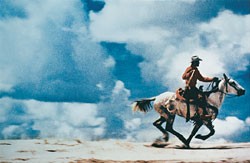
Richard Prince: Untitled (photograph of an advertisement).
The Future of the Book
Some bestseller wannabees are now offered as electronic books and audio files, as well as pokey tomes made out of dead trees. I don't think I'd be comfortable reading an electronic book in the bathtub; and I am not sure I should listen to Kierkegaard while driving on the LIE. But I can't imagine anyone collecting an electronic book or a sound file or that they will ever by worth anything on e-Bay.
Books will make you rich. As they are replaced by new media, they will increase in value. Furthermore, books are the best décor. They are better than paintings. They insulate, sound-proof and advertise.
Advertise?
They tell people who you are. And sometimes this is much better than Judy Holliday's Gladys Clover billboard on Columbus Circle in It Could Happen to You (George Cukor, 1954). The movie was originally titled A Name for Herself.
I have always liked Richard Prince's cowboys, artworks made by rephotographing ads, mostly for Marlboro cigarettes. Wasn't one a billboard showing that emblematic cowboy?
So I was relieved to have my taste confirmed in an odd way by a low-info article in the "Style Section"of the Sunday Magazine of the New York Times last week. We learned that the Guggenheim Museum bought Prince's art-stocked house upstate, but did not learn who paid for it. This purchase was not put in context of other museums that may have acquired similar artist digs, nor did we get a good look at the interior of the house or at much of Prince's art.
What we did see, however, as a bold graphic device, almost as big as Prince's face, a detail of the artist's bookshelves showing the spines of the science-fiction masterpieces of Philip K. Dick (Valis and Do Androids Dream of Electric Sheep?/a.k.a. Bladerunner), not mentioned in the accompanying piece of puffery. Since I think Dick is a genius, my estimation of Prince's talents as an artist increased.
Next entry: July 25
AJ Ads
AJ Blogs
AJBlogCentral | rssculture
Terry Teachout on the arts in New York City
Andrew Taylor on the business of arts & culture
rock culture approximately
Laura Collins-Hughes on arts, culture and coverage
Richard Kessler on arts education
Douglas McLennan's blog
Dalouge Smith advocates for the Arts
Art from the American Outback
For immediate release: the arts are marketable
No genre is the new genre
David Jays on theatre and dance
Paul Levy measures the Angles
Judith H. Dobrzynski on Culture
John Rockwell on the arts
Jan Herman - arts, media & culture with 'tude
dance
Apollinaire Scherr talks about dance
Tobi Tobias on dance et al...
jazz
Howard Mandel's freelance Urban Improvisation
Focus on New Orleans. Jazz and Other Sounds
Doug Ramsey on Jazz and other matters...
media
Jeff Weinstein's Cultural Mixology
Martha Bayles on Film...
classical music
Fresh ideas on building arts communities
Greg Sandow performs a book-in-progress
Exploring Orchestras w/ Henry Fogel
Harvey Sachs on music, and various digressions
Bruce Brubaker on all things Piano
Kyle Gann on music after the fact
Greg Sandow on the future of Classical Music
Norman Lebrecht on Shifting Sound Worlds
publishing
Jerome Weeks on Books
Scott McLemee on books, ideas & trash-culture ephemera
theatre
Wendy Rosenfield: covering drama, onstage and off
Chloe Veltman on how culture will save the world
visual
Public Art, Public Space
Regina Hackett takes her Art To Go
John Perreault's art diary
Lee Rosenbaum's Cultural Commentary
Tyler Green's modern & contemporary art blog

